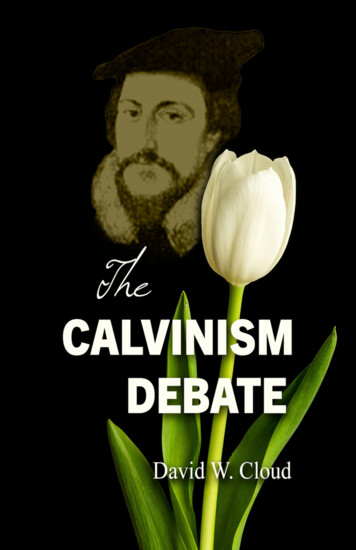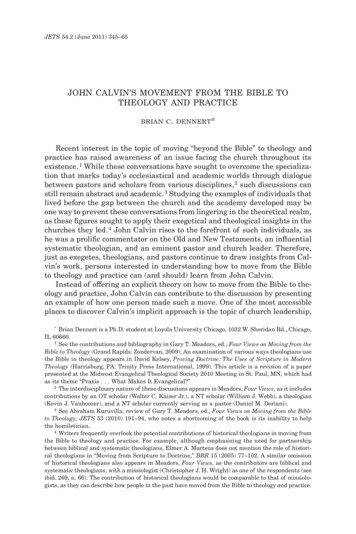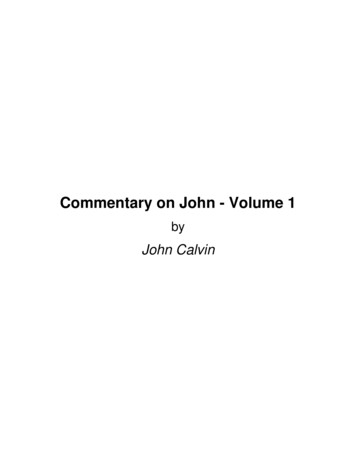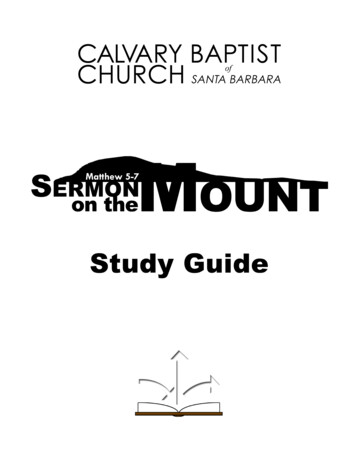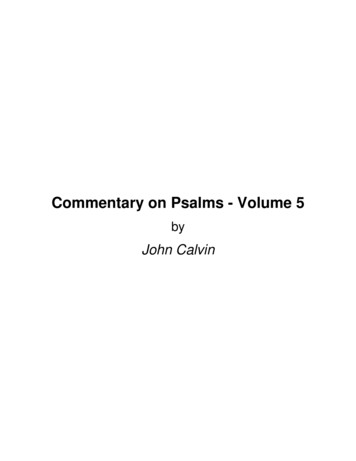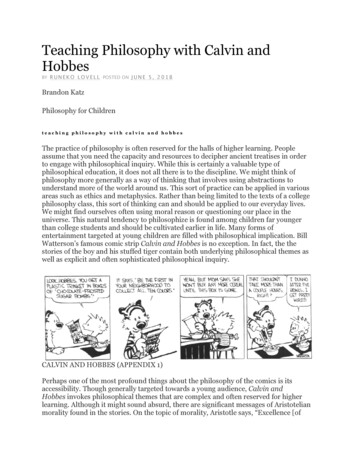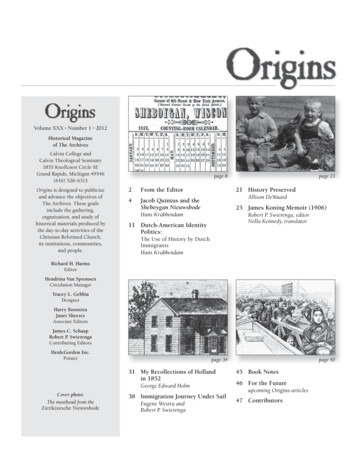
Transcription
Volume XXX Number 1 2012Historical Magazineof The ArchivesCalvin College andCalvin Theological Seminary1855 Knollcrest Circle SEGrand Rapids, Michigan 49546(616) 526- 6313Origins is designed to publicizeand advance the objectives ofThe Archives. These goalsinclude the gathering,organization, and study ofhistorical materials produced bythe day-to-day activities of theChristian Reformed Church,its institutions, communities,and people.page 82From the Editor4Jacob Quintus and theSheboygan Nieuwsbodepage 2321 History PreservedAllison DeWaard25 James Koning Memoir (1906)Hans KrabbendamRobert P. Swierenga, editorNella Kennedy, translator11 Dutch-American IdentityPolitics:The Use of History by DutchImmigrantsHans KrabbendamRichard H. HarmsEditorHendrina Van SpronsenCirculation ManagerTracey L. GebbiaDesignerHarry BoonstraJanet SheeresAssociate EditorsJames C. SchaapRobert P. SwierengaContributing EditorsHeuleGordon Inc.Printerpage 3431 My Recollections of Hollandin 1852George Edward HolmCover photo:The masthead from theZierikzeesche Nieuwsbode38 Immigration Journey Under SailEugene Westra andRobert P. Swierengapage 4045 Book Notes46 For the Futureupcoming Origins articles47 Contributors
from the editor . . .described by Edward Holm of his visitto Holland, Michigan, in 1852 whenhe was eighteen years old.This IssueIn the current issue Allison DeWaard,a student at Dordt College, tells thestory of her family’s efforts at farming near Columbus, Montana. HansKrabbendam, Assistant Director ofthe Roosevelt Study Center in Middelburg, the Netherlands, presents thelife of Jacob Quintus, who publishedthe first Dutch-language newspaper inthe United States and described howDutch identity came to be definedamong immigrants in North America.Next, we present two accounts of theimmigration experience during themiddle of the nineteenth century, thefirst written by Eugene Westra andRobert Swierenga, who also introduced the second account by JamesKoning. Lastly, we include events2Available On-LineThe update of the Banner Index of vitalrecords was updated with 2011 information and published on our ).News from the ArchivesA portion of our time since last fallthat would otherwise have been spentprocessing collections was devotedto moving collections. Late in thefall, phase 1 of the Heritage Hall/RareBooks renovation was completed andwe moved all of the college records,Christian Reformed Church congregational records, genealogical materials, and approximately two-thirds ofour reference collection into the newspace in preparation for the phase 2work. We boxed the remaining reference material and all of our office filesfor moving to the Surge Building, andthen unpacked these there for useuntil we return to the renovated spacein May. By the time you read this weare scheduled to be back in the newlyrenovated space and will gladly giveyou a tour. In the fall issue we willpresent a visual tour of the new facilities.We processed the papers of AndrewBarnes, a specialist in the history ofChristian mission work in the Sudan.The papers contain many originaldocuments and unique secondarysources on the CRC mission effortsbeginning there in the 1930s. Wealso opened for research the personalpapers of Rev. Bartel Huizenga, history professor Henry Ippel, economicsprofessor John Tiemstra, as well asthe first day postal covers collectionby John Cevaal. Work on the translation of the Holland, Michigan, CentralAvenue CRC minutes through 1927continues, as does keying in data ofvital records information from theBanner, and family data in the Calvinist Contact. Work has also begun on
Volume XXX Number 1 2012organizing the records of the churchplants in the CRC Home Missions collection as well as the extensive papersof Dr. Vernon Ehlers who served onthe Kent County Board of Commissioners, in the Michigan Legislature,and in the US House of Representatives.Noteworthy among the archival accessions were twenty-one boxes fromCRC Home Missions and six boxesfrom the college Provost. The HomeMissions material contains significantinformation on church plants during the past four decades. Among thepersonal papers received were thoseof geologist Clarence Menninga anda significant addition to the papersdonated by Diet Eman, who workedin the Dutch resistance during WorldWar II.PublicationsIn early November Richard Harmswas invited to present a paper basedon his research on the tensions amongDutch immigrants in West Michigan,1847-1857, at a conference in recognition of the 200th anniversary ofthe birth of Dr. A. C. Van Raalte. Hewas one of six presenters asked toparticipate at both the conference inHolland, Michigan, and the followingweek in Ommen, the Netherlands. Aspart of this, media in both locationsinterviewed him, and a Dutch translation of his presentation was publishedonline by the Trouw. The full researchpaper will be published in a bookof proceedings produced by the VanRaalte Institute and the Free University of Amsterdam.StaffRichard Harms is the curator ofthe Archives; Hendrina Van Spronsen is the office coordinator; whileWendy Blankespoor our librarianand cataloging archivist is on leave,Diane Vander Pol has joined the stafffor several months; Laurie Haan isdepartment assistant; Dr. Robert Boltis field agent and assistant archivist.Our student assistant is Ben Rietema.Our volunteers include Rev. Dr. PaulBremer, Mrs. Willene De Groot, Mr.Ed Gerritsen, Mr. Fred Greidanus, Mr.Ralph Haan, Mrs. Helen Meulink, Rev.Gerrit W. Sheeres, Mrs. Janet Sheeres,and Mr. Ralph Veenstra.Endowment FundCurrently our endowment fundand operating fund have a value of 492,921. Of this, 100,000 will beused to offset the current renovationproject, but our annual subscriptionrate remains at 10, even though 10 no longer covers the cost for thetwo mailings a year. As always, weare grateful to our supporters, manyof whom contribute well above thesubscription cost.DRichard H. Harms3
Jacob Quintus and theSheboygan NieuwsbodeHans KrabbendamJSince 1990 Dr. Hans Krabbendam hasbeen with the Roosevelt Study Centerin Middelburg, The Netherlands, currently serving as its assistant-director.He is the author of several books andnumerous articles in the intersectionsof Dutch immigration history, religioushistory, and Dutch-American relations.4acob Quintus (1821-1906), son ofa teacher in a small village in theDutch province of Zeeland, has beenlargely forgotten in the Netherlands.In the United States his editorship ofthe first Dutch-American newspaper(1849-1861) saved him from oblivion.One might argue that Quintus wasnot unique, since many other publications were launched in the immediateyears, but his publication was the firstsuccessful enterprise and acted as aninspiration to others who recognizedthe Sheboygan Nieuwsbode as themodel for the Dutch-language press inthe United States.The activities of Quintus reveal,in detail, the stream of informationbetween the sources of emigration inthe Netherlands and settlement areasin the United States. While the corpusof the fifty-some Dutch-language publications has been well documented,little is known about the motives, theinstruments, and the decisions aneditor made. Quintus’s work revealsin detail his selection decisions, whilehis later editorial work confirmed thathe was an irrepressible newspaperman.His career documents the roleof non-clergy in the pioneer phaseof Dutch immigration. Further, thelocation of this first newspaper officeis significant and Quintus’s moveto Michigan helps to explain whythough the Badger State had been thedestination of the early immigrants,Michigan became the center of Dutchimmigration in the US.Jacob Quintus (1821-1906), from the Dutchprovince of Zeeland, edited the first DutchAmerican newspaper (1849-1861). Imagecourtesy of the Archives, Calvin College, GrandRapids, Michigan.Finally, there is an additional academic reason for a renewed interestin his life. One of the new questionsin migration history focuses on theconnections between areas and peoplethat transcend national boundariesand national origin: the issue of transnationalism. Early ethnic newspapersfunctioned in this space between twonations and the way in which editorssuch as Quintus advanced transnational connections helps to understand this process.OriginsJacob Quintus was born in
Volume XXX Number 1 2012Zonnemaire, on the island of Duiveland, the northern most part of theprovince of Zeeland, on ChristmasEve 1821. He was the youngest son ofJan Quintus, who died before Jacob’sfirst birthday. At age ten his motherNeeltje Slagboom (1792-1831) alsopassed away, leaving Jacob an orphan.Thanks to an earlier marriage of hisfather, who was sixty-five when Jacobwas born, he had enough relatives inthe province to take care of him. Anumber of them were craftsmen livingin Zeelandic Flanders,1 others wereteachers. The Quintus family was partof the lower middle class; they ownedtheir home in Zonnemaire, ten acresof farmland, and some stock in ruralindustry.2Jacob followed in the footsteps ofhis late father and became an assistantteacher in Haamstede on the island ofSchouwen. At age eighteen he enteredthe lowest category of teachers, anassistant to a teacher. While he servedalternately in various regions wherehis relatives lived, he became an assistant teacher on his native Schouwen in 1847. Jacob had ambition, butlacked opportunities. He had acquireddiplomas to teach foreign languages,but the economic crisis kept manychildren out of school and preventedhim from earning further promotion.Practical, well-informed, a wellconnected person, full of initiative,and with a good sense for business,Quintus in the late 1840s was interested in emigration, the talk of thetown, especially in Zeelandic Flanders, where laborers had been leavingfor New York and Wisconsin beforeDutch immigrants under the leadership of the ministers Albertus VanRaalte and Hendrik Scholte launchedthe era of large-scale Dutch migration. Wisconsin had attracted manysettlers from Zeeland, who settled inthe Milwaukee area: Gerardus Brandtfrom Kapelle in Bethlehem (or “TownEight,” eight miles north of Milwau-kee); Jan Kotvisand Pieter Lankester from Middelburg, south of thiscity in FranklinPrairie. In 1845,similar groupsfrom westernZeelandic Flanders had founded“Town Thirteen,”two years laterrenamed “TownHolland,” southof Sheboygan,and then namedOostburg. Theexpectations forthe developmentof Wisconsin werehigh; Scholte andVan Raalte intendQuintus was born in Zonnemaire, on the island of Duiveland, in theed to settle in thenorthern part of the province of Zeeland.state, until AmeriAmong the travelers was the thirtycan contacts persuaded them to settleone-year-old Frans van Driele (1816in Iowa and Michigan, respectively.1900) from Goes, who was very muchThe departure of the large group oflike Quintus. Van Driele came from457 from the center of the province,a family that had lost a parent andheaded by Seceders in April 1847,had learned at an early age to supportmade a deep impression on Jacob.himself. He worked as a baker’s apHis brother-in-law, Leendert Dooge,prentice in various places and later aswho was a painter and an emigraa traveling salesman in haberdasherytion agent, made him aware thatand books. He used his savings for theemigration was a viable solution fortrip to the United States and wouldthe economic stagnation in Zeeland.become a leading Dutch communityHis friend Pieter Souffrouw addedleader and elder in the Reformedvaluable personal experiences. Thischurch in Grand Rapids.watchmaker had returned from WisThe party sailed from Zeeland onconsin to bring his mother, two broth6 August 1847 on Charles Humberers, and four sisters to the Americanston. A strong countering wind in theMidwest. On 10 July 1847, SouffrouwEnglish Channel stranded the ship onand Dooge placed an announcementa sand bank close to Calais. The pasin the Zierikzeesche Nieuwsbode,sengers were rescued and set ashore atrecruiting passengers for a quick deCalais, where they were treated wellparture in August. A group of eightywith bread and warm milk, and thenartisans and small businessmen fromcontinued their journey via Le Havre.Axel, Oostburg, Terneuzen, Zierikzee,Quintus’s knowledge of French andBommenede, Goes, and ZonnemaireGerman was useful when talking to(all towns in Zeeland) joined the two.the authorities and negotiating withThis exodus was a business enterthe other, mostly German, immigrantsprise and not religiously motivated.5
The masthead from the Zierikzeesche Nieuwsbode. Zierikzee is just south of Zonnemaire also on the island of Duiveland. Image courtesy of the author.to find an alternate ship. This resultedin their departure on Robert Parker,which five weeks later, on 27 September, brought the company to NewYork.3During the trip Quintus had grownas a leader and after arriving hecontinued to seek opportunities asan information broker for his fellowcountrymen in Albany, where hisbrother-in-law Dooge acted as agentfor immigrants en route to Buffalo.4They became partners who contractedwith a person in New York to arrange transportation for immigrantsto Albany. They made reservations oncanal boats to Buffalo and lake vesselson the Great Lakes. In the processQuintus taught the new arrivals thebasics of the English language. Thisproject was successful because manyDutch immigrants, while literate,lacked English-language skills. Soonhe published a Dutch-English dictionary as part of this instruction.5The Dutch immigrant group inAlbany was diverse and transient.It wasn’t until 1859 that they organized their own congregation.Quintus’s many contacts and theneed for information led him to sellthe Zierikzeesche Nieuwsbode in theUnited States. On 24 July 1848 thenewspaper announced that J. Quintusin Buffalo (and in Albany in 1849)6sold three-month subscriptions tothe Dutch periodical for 1.10. ThisDutch newspaper from his homeregion had a circulation of 1,500 andwas a commercial success. It ventedthe frustrations of the Dutch whowere dissatisfied with the economicstagnation and high taxes in theNetherlands which did not benefit thecitizens.6Since the weekly importation ofDutch newspapers was costly and timeconsuming, Quintus tried publishinga Dutch-language newspaper in NewYork State. However, he had to abandon the project when other publishersset up De Nederlander in Noord-Amerika (The Dutchman in North America)and ruined the reputation of suchenterprises by depositing subscriptionmoney, publishing eight issues, andthen canceling the operation—to thedisappointment of their subscribers.7Quintus realized that a trustworthyenterprise could work and discoveredthat the West offered a faster growingmarket and therefore was more promising than New York. He decided tomove to Wisconsin to join his futurein-laws in the spring of 1849 and theredetermined to make a second effortto realize his plan to provide Dutchimmigrants in the US with news abouttheir homeland, their new environment, and each other.To WisconsinQuintus’s departure from New Yorkfit into the typical pattern of Dutchimmigrants. Most of them had sufficient funds for passage, but not tobuy property upon arrival. A temporary stay in the East, building canalsor railroads, generated the capitalto invest in farms and businesses inthe Midwest. Frans Van Driele, forinstance, had labored on the Delaware& Hudson Canal for nine months before he moved on to West Michigan.8Quintus traveled to Sheboygan,where members of his immigrantparty had settled. It is likely thathe had an eye on Pieter Souffrouw’ssister, Catharina, whom he marriedshortly after his arrival in the springof 1849.When he arrived in Sheboygan,the town had just 700 inhabitants. Herealized that his clientele needed morethan the (old) news from Zierikzee.So, on 16 October 1849, he launchedhis own newspaper, only changing theplace name to the Sheboygan Nieuwsbode, the first Dutch-language newspaper published in North America.He built it into a business, opened aprinting shop, and offered additionalservices as a notary public. Quintusjoined his brother-in-law Souffrouwin local politics. They both supportedthe Democrats against the Whigs and
Volume XXX Number 1 2012hoped to increase Jacob’s businessenterprise in this way.The Sheboygan Nieuwsbode beganas a double-paged newspaper withnews from Dutch immigrants in theSheboygan area, local advertisements,and summaries of the news fromDutch and American newspapers.Within a year the size doubled tofour densely printed pages. Quintusrecruited an extensive network of local correspondents to provide information and retailers (often the sameperson) to distribute his newspaper.He wrote the copy and reprintedarticles from other sources. A shortpoem illustrated this method: “DeRedacteur zit neer, met kranten overladen, Bijna verdwaald in ’t nieuws,van alle nieuwsbladen.” (The editorsits down, burdened by many newspapers, almost lost in the news fromall the periodicals.)9 Thanks to hiscircle of mostly Zeeland agents, whoand Van Raalte, spread the word andwhose persuasive powers made theminto two prominent leaders in otheraspects of immigrant life in their communities. However, there were differences with Badger State immigrantswho did not necessarily share thesame religious aspirations as their kinin Michigan and Iowa. Instead of ministers, Dutch business leaders, such asQuintus and Milwaukee lawyer andDutch consul Gijsbert van Steenwijk,were instrumental in promotingsettlement in Wisconsin.Quintus’s Wisconsin promotionpraised the state’s export routes forits mining and agricultural products,via the Great Lakes to the East orvia the Mississippi in the South andWest. He announced that large tractsof land were still available and cheap.The air was much healthier than inMichigan, which was plagued by“fever and ague” caused by stagnantThe first issue of the Sheboygan Nieuwsbode. Notice the similarity with the ZierikzeescheNieuwsbode. Image from microfilm in the Archives, Calvin College, Grand Rapids, Michigan.received a free subscription as compensation, Dutch immigrants receivedinformation about the movements oftheir ilk. He gradually expanded hissources from only Zeeland to American newspapers and used his Buffalocontacts for news about the East. Ofcourse he promoted Wisconsin in hisnewspaper and sent copy for publication in his native country.10In promotional aspects Wisconsindiffered from Iowa and Michigan,where ministers, particularly Scholtewater in that tree-covered state. Heclaimed that this reason had encouraged hundreds of Michigan citizensto move west. Even more promisingfor farmers was that the states of Iowaand Wisconsin would soon be connected to the East via railroads.11Through the years, Quintus developed a good compass for economicopportunities and political currents.He maintained an excellent nationalnewspaper network, both in the Netherlands and increasingly within theUnited States. He closely monitoredthe immigrant flows as he had doneback home, where his brother-in-lawLeendert Dooge had been an immigrant agent. In Wisconsin Quintusprinted statistical overviews for thestate which kept readers informedabout new business opportunities.In addition to his printing business,Quintus sold coffee and Dutch gin. In1855 he was ready for expansion andhe dropped the name Sheboygan fromthe title and hoped to attract a broader clientele with the name Nieuwsbode.12 More than other newspapers,Quintus's newspaper looked beyondthe horizon at railroad planning, newlegislation, the court system, education, and promising new economicactivities such as growing tobacco orproducing cheese.While the Nieuwsbode had manyAmerican features, there remainedmuch continuity between theZierikzeesche and the SheboyganNieuwsbode. As the Zeeland newspaper took sides for the workers intheir struggles with owners, Quintussupported the Democrats against thearistocratic Whigs. At the beginningof 1850 he wrote: “. . . we believethat each reader has long felt thatwe adhere to the teachings of Jefferson . . . . He, the true democrat,acknowledges all the classes of his fellow citizens, and treats the poor withequal respect as the rich. He spreadswith speed the truths of the democratic faith and contributes to themaintenance of the correct principlesand the everlasting continuity of ourfree institutions and laws.”13Of course his preference was alsoguided by the profitability of politicalconnections. Local newspapers couldonly survive thanks to printing government documents which were allocated as political gifts to supporters.Quintus’s efforts to run for local offices failed, even though he also printedthe English-language Democratic7
The 16 January 1855 issue of the Nieuwsbode, when Quintus dropped thegeographic limiter of Sheboygan from the masthead. Image from microfilm in theArchives, Calvin College, Grand Rapids, Michigan.Secretary. In 1854 he joined the Republican Party out of frustration withslavery, but possibly also in aspirationof elective office.14 He served as clerkof court for two years, but was defeated and he returned to the DemocraticParty in 1857 because of the radicalideas on abolition, a campaign againstimmigrants, and opportunism by theRepublicans. These shifting politicalallegiances made his readers nervousand many canceled their subscriptions. The political vicissitudes were aforeboding of more change.During the economically unstable1850s, Quintus concluded thatSheboygan was not the best location to realize his ambition. In May1857 Quintus visited Grand Rapids,Michigan, and became convinced thatthis city had a great future and woulddevelop into the second largest cityin the state, thanks to its cheap andabundant waterpower, cheap buildingmaterials, and developing rail connections. He saw three railroads approachthe city and connect the various corners of the state, generously fundedby land grants. The city boastedexcellent educational opportunities, avariety of churches, and well-stockeddepartment stores, among them onecalled the “New Dutch Store” in thecity center, owned by his brother-inlaw Leendert Dooge. Many Holland8ers found jobs in thecity’s factories andworkshops. Also, thesurrounding area wasprospering and thehopes of a good portincreased the prospects for a Hollandharbor.15In the spring of1858 Quintus decidedto sell his newspaperto his German coeditor and translator, A.Pott, and take hisfamily on a trip tothe homeland. Thesummer of 1858 wasa turning point in hislife. Not often didimmigrants decide toreturn to their native country so soonfor a visit. On 3 JuneQuintus, his wife, andfour-year-old daughter Jennie landed inRotterdam and visitedrelatives in Zeelandfor three months.After their return tothe US they settledin Grand Rapids.16Whether the economic crisis and the cropAdvertisement by Quintus for his printing services. Image courtesyof the author.
Volume XXX Number 1 2012failures of 1857 stimulated his departure, or whether he had alienated hisreaders by moving back and forth between the Democratic and Republicanparties, or whether his decision wastriggered by his political defeat, or hisfailing health, is not easy to say. Mostlikely all of these factors added up tohis decision to move and it appearedto be a good one.Quintus did well in Grand Rapidswhere he continued to deal in newspapers. For seven years he publishedthe Americaansche Stoompost (American Steampost) from 1859-1866, andonce again in 1884 with the NieuweCourant.17 Because only one issue ofthis later publication survived, little isknown about his publishing activitiesin Michigan. However, the Stoompostclosely resembled the Nieuwsbode. Despite the term “American” in the title,it brought mainly a variety of Dutchand European news stories, listed newimmigrants and lost relatives, clippedstories from other Dutch-Americanperiodicals, and printed many commercial announcements. It claimedthe largest circulation among Dutchnewspapers in the Union. There wasmore continuity with the Wisconsinperiod in Quintus’s efforts to combinecommercial, editorial, and political initiatives. As in Wisconsin, hispolitical career in Michigan quicklyfaded. Though he served as schoolsupervisor in 1861, he failed to beelected to other offices.18 In contrast,his business enterprise flourished. Hedealt in real estate, opened an officeas a notary public (mainly to retrieveinheritances in the old country), soldlife insurance, and was an agent forvarious shipping companies. According to the tax assessment records hisproperty jumped from 500 in 1850to 6,000 ten years later and 40,000in 1870.19 He remained at the coreof the Dutch (business) community,though religiously he moved a bitoutside the mainstream. He left theReformed churchfor the mysticgroup of the Swedenborgians. Thethirtieth anniversary of the founding of the Dutchsettlement on thefirst of October1877 took placein his home at 18Prospect Street,in Grand Rapids’best neighborhood.20After the deathof his wife CathaA 2008 image of the house Quintus lived in after he moved to Grandrina in 1903,Rapids, Michigan. Image courtesy of the author.Quintus movedwho represented them in the state andin with daughter Jennie in Plainwell,maintained unity in times of pressure.Michigan, where he died in 1906, atThe average Wisconsin immithe age of eighty-five. He had showngrant had sufficient means to surthat it was also possible to makevive without the strong communityconnections among the Dutch immisupport present in other states. Butgrants outside the religious networksthe fact that railroad lines connectand that a newspaper in the Dutching the Sheboygan area to easternlanguage was a necessity.21and western markets were estabConclusionlished relatively late, and the lack ofJacob Quintus’s departure fromsymbiotic (and mutually beneficial)Wisconsin ended the Dutch-languagerelationships between urban and ruralpress in the state for fifteen years. Itsettlements—as in Michigan betweenwould be 1878 before another DutchGrand Rapids, Holland, and theirlanguage periodical, De Standaard,satellite villages— capped the growthwould be printed. This newspaperin Wisconsin. These developmentsserved Flemish and Dutch Cathoattracted immigrants who were lesslics. In the meantime the center ofinterested in following strong clerithe Dutch Protestants had becomecal leadership so that churches werefixed permanently in Michigan. Thenot able to generate further culturalSheboygan Nieuwsbode had not indevelopment.tended this shift, but contributed to itIt is unlikely that editor Jacobnonetheless by reporting on the sucQuintus was aware of all these factors,cesses of the Dutch there and in othereven though he had the best overviewplaces. The Dutch Protestant colonyto compare the conditions in the variin Wisconsin developed differentlyous Dutch settlements. His experifrom those in Michigan and Iowa. The ences demonstrate the differencespioneers there did not settle with anin the Dutch immigrant experience.overarching plan for the developmentHis unique Sheboygan Nieuwsbodeof the area, as in Holland and Zeedid not survive the Civil War, butland, Michigan, and Pella, Iowa. Theyother periodicals took over the rolelacked strong and visionary leadersin the Dutch-American community.229
A bookplate from one of Quintus’s books thatis now in the collection of the Grand RapidsPublic Library. Image courtesy of the author.The first successful Dutch-Americaneditor began his enterprise copyinga Dutch example, then adapting it toAmerican experience.oEndnotes1. The southernmost portion of theprovince on the border with Belgium.2. Zierikzeesche Courant, 27 Oct.1837.3. Zierikzeesche Nieuwsbode, 26 Aug.1847 and Jacob Quintus, “Een terugblikover vijftig jaren,” (An overview of fiftyyears) De Grondwet, 21 Nov. 1911.4. Henry S. Lucas, ed., Dutch Immigrant Memoirs and Related Works, 2 vols.(Assen: Van Gorcum, 1955; repr. GrandRapids: Eerdmans, 1997) vol 2: 294-300and 435-439.5. H. Picard, De Hollander in Amerika.Leerwijze der Engelsche taal door H.P.; tendienste mijner landgenooten ter drukkingovergegeven door J. Quintus, onderwijzerin de Engelsche, Hollandsche en Franschetalen (The Dutchman in America: Teachingmethod of the English language by H.P.;printed for my fellow countrymen by J.Quintus, teacher of the English, Dutch,and French languages) (Buffalo, NY: O.G. Steele, 1848) 77 pp. Steele printed,bound, and sold books in the centerof Buffalo at 206 Main Street. He sold10school books, Bibles, maps, stationeryand planned to publish a Dutch almanacin 1849. Quintus explained in the preface that the demand for this dictionarysurpassed the supply from the Netherlands.6. Jan van Damme, “De standenmaatschappij in de Zierikzeesche Nieuwsbode,1844-1846” (MA thesis, Radboud Universiteit Nijmegen, 1978).7. Prospectus published in 1848 according to the Sheboygan Nieuwsbode, 16Oct. 1849.8. In the fall of 1851 Leonard (Leendert) Dooge moved to Ravenna, close toMuskegon in Michigan, and later movedto Grand Rapids. Lucas, Dutch ImmigrantMemoirs, 1: 356-358.9. Cited in J. Breur, “De SheboyganNieuwsbode. Het eerste Nederlandstaligenieuwsblad in de Verenigde Staten 18491861” (MA thesis, Radboud UniversiteitNijmegen, 1991).10. Zierikzeesche Nieuwsbode, 17 Oct.1850.11. Sheboygan Nieuwsbode, 9 and 16Apr. 1850.12. Ibid, 3 Mar. 1855.13. Sheboygan Nieuwsbode, 29 Jan.1850.14. The first issue of the DemocraticSecretary appeared on 7 Oct. 1853, butit folded after a year. The State Historical Society of Wisconsin in Madisonpreserves the one and only copy. Quintusbecame the secretary of the County Convention of the Republicans on 25 Oct.1854 (Sheboygan Nieuwsbode, 31 Oct.1854). The voters elected him on 7 Nov.1854 as Clerk of Court with 930 to 737votes (Sheboygan Nieuwsbode, 14 Nov.1854), but he was defeated in 1856.15. Sheboygan Nieuwsbode, 16 Jun.1857.16. Pott returned the newspaper tothe Republicans, but it folded on 8 May1861. Jacob’s wife Catharina WilhelminaSouffrouw was born in Oostburg, Zee-land, on 8 Oct. 1824, where she laterkept a store. The
Historical Magazine of The Archives Calvin College and Calvin Theological Seminary 1855 Knollcrest Circle SE Grand Rapids, Michigan 49546 (616) 526-6313 Origins is designed to publicize and advance the objectives of The Archives. These goals include the gathering, organization, and study of historical materials produced by

